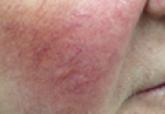The fourth article in this 5-part series reviews physical modalities and devices used to treat cutaneous rosacea based on consensus recommendations from the American Acne & Rosacea Society (AARS) on the management of the common presentations of cutaneous rosacea. The major therapeutic uses of physical modalities and devices, especially laser and light-based systems, are for treatment of telangiectases and persistent facial erythema (background erythema). Phymas, especially rhinophyma, also are treated with physical modalities such as ablative lasers or surgical devices (eg, electrosurgical loop). Appropriately selected and properly used lasers and intense pulsed light (IPL) devices can successfully address specific clinical manifestations of rosacea that exhibit limited or no response to available medical therapies, such as telangiectases and background centrofacial erythema. Rosacea-associated symptoms also may improve. In most cases, treatment will need to be repeated intermittently to sustain improvement.


